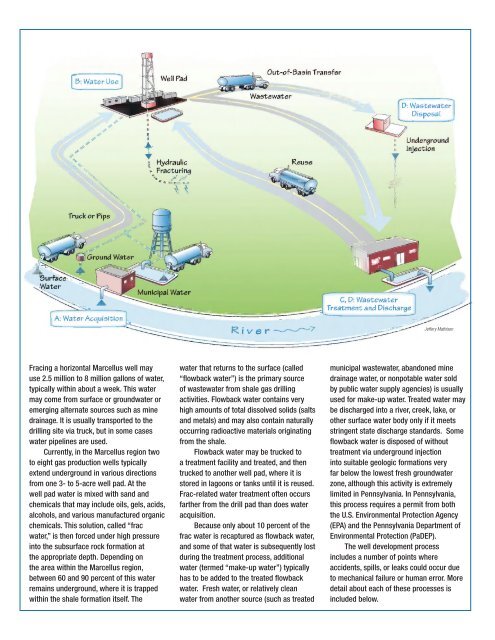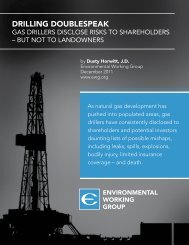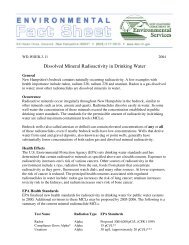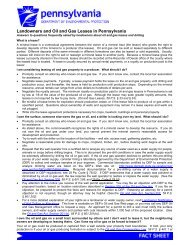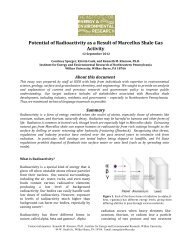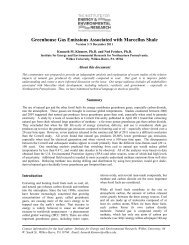Water's Journey Through the Shale Gas Drilling and Production ...
Water's Journey Through the Shale Gas Drilling and Production ...
Water's Journey Through the Shale Gas Drilling and Production ...
You also want an ePaper? Increase the reach of your titles
YUMPU automatically turns print PDFs into web optimized ePapers that Google loves.
Jeffery Mathison<br />
Fracing a horizontal Marcellus well may<br />
use 2.5 million to 8 million gallons of water,<br />
typically within about a week. This water<br />
may come from surface or groundwater or<br />
emerging alternate sources such as mine<br />
drainage. It is usually transported to <strong>the</strong><br />
drilling site via truck, but in some cases<br />
water pipelines are used.<br />
Currently, in <strong>the</strong> Marcellus region two<br />
to eight gas production wells typically<br />
extend underground in various directions<br />
from one 3- to 5-acre well pad. At <strong>the</strong><br />
well pad water is mixed with s<strong>and</strong> <strong>and</strong><br />
chemicals that may include oils, gels, acids,<br />
alcohols, <strong>and</strong> various manufactured organic<br />
chemicals. This solution, called “frac<br />
water,” is <strong>the</strong>n forced under high pressure<br />
into <strong>the</strong> subsurface rock formation at<br />
<strong>the</strong> appropriate depth. Depending on<br />
<strong>the</strong> area within <strong>the</strong> Marcellus region,<br />
between 60 <strong>and</strong> 90 percent of this water<br />
remains underground, where it is trapped<br />
within <strong>the</strong> shale formation itself. The<br />
water that returns to <strong>the</strong> surface (called<br />
“flowback water”) is <strong>the</strong> primary source<br />
of wastewater from shale gas drilling<br />
activities. Flowback water contains very<br />
high amounts of total dissolved solids (salts<br />
<strong>and</strong> metals) <strong>and</strong> may also contain naturally<br />
occurring radioactive materials originating<br />
from <strong>the</strong> shale.<br />
Flowback water may be trucked to<br />
a treatment facility <strong>and</strong> treated, <strong>and</strong> <strong>the</strong>n<br />
trucked to ano<strong>the</strong>r well pad, where it is<br />
stored in lagoons or tanks until it is reused.<br />
Frac-related water treatment often occurs<br />
far<strong>the</strong>r from <strong>the</strong> drill pad than does water<br />
acquisition.<br />
Because only about 10 percent of <strong>the</strong><br />
frac water is recaptured as flowback water,<br />
<strong>and</strong> some of that water is subsequently lost<br />
during <strong>the</strong> treatment process, additional<br />
water (termed “make-up water”) typically<br />
has to be added to <strong>the</strong> treated flowback<br />
water. Fresh water, or relatively clean<br />
water from ano<strong>the</strong>r source (such as treated<br />
municipal wastewater, ab<strong>and</strong>oned mine<br />
drainage water, or nonpotable water sold<br />
by public water supply agencies) is usually<br />
used for make-up water. Treated water may<br />
be discharged into a river, creek, lake, or<br />
o<strong>the</strong>r surface water body only if it meets<br />
stringent state discharge st<strong>and</strong>ards. Some<br />
flowback water is disposed of without<br />
treatment via underground injection<br />
into suitable geologic formations very<br />
far below <strong>the</strong> lowest fresh groundwater<br />
zone, although this activity is extremely<br />
limited in Pennsylvania. In Pennsylvania,<br />
this process requires a permit from both<br />
<strong>the</strong> U.S. Environmental Protection Agency<br />
(EPA) <strong>and</strong> <strong>the</strong> Pennsylvania Department of<br />
Environmental Protection (PaDEP).<br />
The well development process<br />
includes a number of points where<br />
accidents, spills, or leaks could occur due<br />
to mechanical failure or human error. More<br />
detail about each of <strong>the</strong>se processes is<br />
included below.


